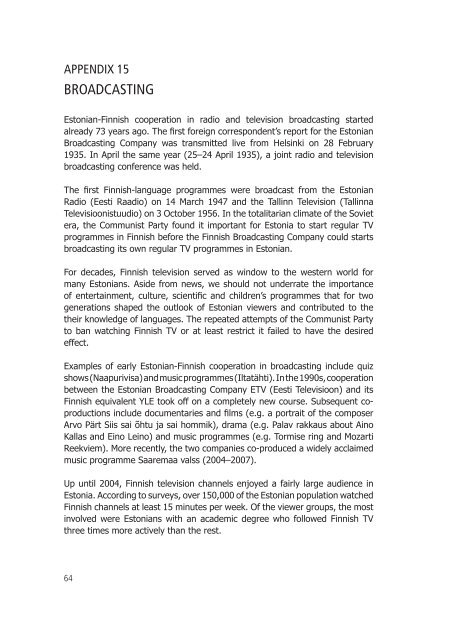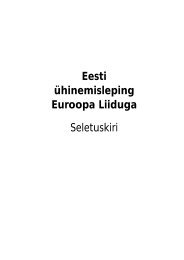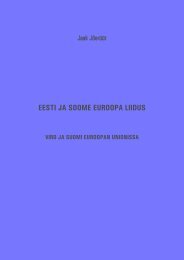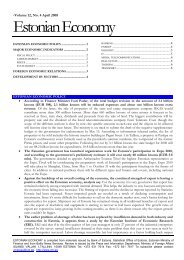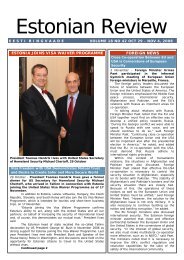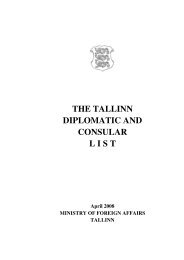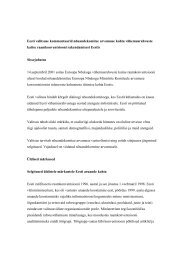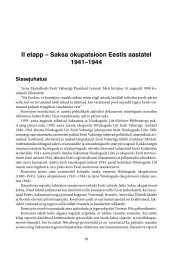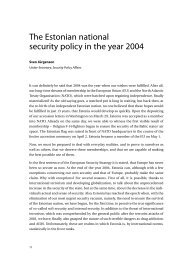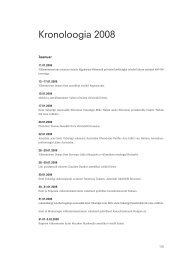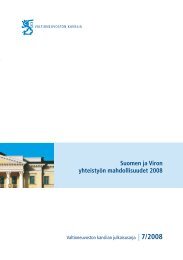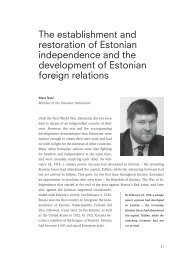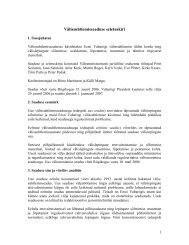Opportunities for Cooperation between Estonia and ... - Valitsus
Opportunities for Cooperation between Estonia and ... - Valitsus
Opportunities for Cooperation between Estonia and ... - Valitsus
Create successful ePaper yourself
Turn your PDF publications into a flip-book with our unique Google optimized e-Paper software.
APPENDIX 15<br />
BROADCASTING<br />
<strong>Estonia</strong>n-Finnish cooperation in radio <strong>and</strong> television broadcasting started<br />
already 73 years ago. The first <strong>for</strong>eign correspondent’s report <strong>for</strong> the <strong>Estonia</strong>n<br />
Broadcasting Company was transmitted live from Helsinki on 28 February<br />
1935. In April the same year (25–24 April 1935), a joint radio <strong>and</strong> television<br />
broadcasting conference was held.<br />
The first Finnish-language programmes were broadcast from the <strong>Estonia</strong>n<br />
Radio (Eesti Raadio) on 14 March 1947 <strong>and</strong> the Tallinn Television (Tallinna<br />
Televisioonistuudio) on 3 October 1956. In the totalitarian climate of the Soviet<br />
era, the Communist Party found it important <strong>for</strong> <strong>Estonia</strong> to start regular TV<br />
programmes in Finnish be<strong>for</strong>e the Finnish Broadcasting Company could starts<br />
broadcasting its own regular TV programmes in <strong>Estonia</strong>n.<br />
For decades, Finnish television served as window to the western world <strong>for</strong><br />
many <strong>Estonia</strong>ns. Aside from news, we should not underrate the importance<br />
of entertainment, culture, scientific <strong>and</strong> children’s programmes that <strong>for</strong> two<br />
generations shaped the outlook of <strong>Estonia</strong>n viewers <strong>and</strong> contributed to the<br />
their knowledge of languages. The repeated attempts of the Communist Party<br />
to ban watching Finnish TV or at least restrict it failed to have the desired<br />
effect.<br />
Examples of early <strong>Estonia</strong>n-Finnish cooperation in broadcasting include quiz<br />
shows (Naapurivisa) <strong>and</strong> music programmes (Iltatähti). In the 1990s, cooperation<br />
<strong>between</strong> the <strong>Estonia</strong>n Broadcasting Company ETV (Eesti Televisioon) <strong>and</strong> its<br />
Finnish equivalent YLE took off on a completely new course. Subsequent coproductions<br />
include documentaries <strong>and</strong> films (e.g. a portrait of the composer<br />
Arvo Pärt Siis sai õhtu ja sai hommik), drama (e.g. Palav rakkaus about Aino<br />
Kallas <strong>and</strong> Eino Leino) <strong>and</strong> music programmes (e.g. Tormise ring <strong>and</strong> Mozarti<br />
Reekviem). More recently, the two companies co-produced a widely acclaimed<br />
music programme Saaremaa valss (2004–2007).<br />
Up until 2004, Finnish television channels enjoyed a fairly large audience in<br />
<strong>Estonia</strong>. According to surveys, over 150,000 of the <strong>Estonia</strong>n population watched<br />
Finnish channels at least 15 minutes per week. Of the viewer groups, the most<br />
involved were <strong>Estonia</strong>ns with an academic degree who followed Finnish TV<br />
three times more actively than the rest.<br />
64


